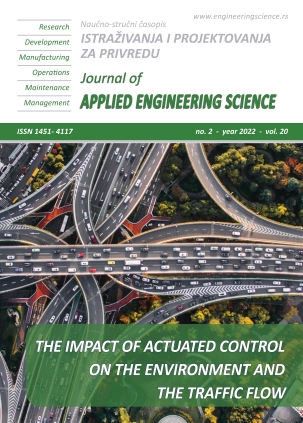ENGINE PROPELLER MATCHING ANALYSIS ON FISHING VESSEL USING INBOARD ENGINE
Abstract
Fishing vessels which are used for one day operations usually use outboard engines as their driving motor. However, to improve the performance of propulsion systems, and consequently the performance of ships, inboard engines are now being used. In this study, the propulsion system of a ship was modified by upgrading from an outboard to an inboard motor. Meanwhile, the study aims to obtain an optimal interaction between the propulsion system and the hull shape of the ship. It was conducted by calculating the ship’s resistance using the van Oortmerssen method, and validating the result using the CFD method. Furthermore, thrust and torque calculations were performed to obtain the characteristics of the ship’s propellers, and the results were validated using the CFD method. The result obtained from the calculation of the ship’s resistance was a New Fishing Vessel engine power of 11 HP. 4 types of B-Series propellers characterized based on the size of their pitch, including 14.00 inch, 14.25 inch, 14.50 inch, and 14.75 inch were, analyzed using the engine propeller matching analysis. The results show that the propeller with the pitch size of 14.75 inches was the best, as it had a power of 100%, speed of 25.35%, and efficiency of 32%. Therefore, it was chosen as the new propeller for New Fishing Vessels.
References
JIN, DI, KITE-POWELL, HAUKE L., THUNBERG, ERIC, SOLOW, ANDREW R. and TALLEY, WAYNE K., 2002, A model of fishing vessel accident probability. Journal of Safety Research. 2002. Vol. 33, no. 4, p. 497-510. DOI 10.1016/s0022-4375(02)00050-6. Elsevier BVMolland, Anthony F, 2017, Ship Resistance and Propulsion. 2. Cambridge : Cambridge University Press..
Trimulyo, Andi, 2015, Efficiency Analysis of B-Series and Kaplan Propellers on Ari 400 Hp Tugboats With Variations in Number of Blades and Rake Angles Using CFD. Naval Architecture Journal. 2015. Vol. 12, no. 4.
WANG, ZHITAO, MA, JIAYI, YU, HAICHAO and LI, TIELEI, 2021, Research on Matching Characteristics of Ship-Engine-Propeller of COGAG. Volume 1: Aircraft Engine; Fans and Blowers; Marine; Wind Energy; Scholar Lecture. 2021. DOI 10.1115/gt2021-59788. American Society of Mechanical Engineers.
MARQUES, C.H., BELCHIOR, C.R.P. and CAPRACE, J.-D., 2018, Optimising the engine-propeller matching for a liquefied natural gas carrier under rough weather. Applied Energy. 2018. Vol. 232,p. 187-196.DOI 10.1016/j.apenergy.2018.09.155. Elsevier BV
Samuel, Samuel, Muhammad, Iqbal and I Ketut, Aria Utama, 2016, An Investigation into the Resistance Components of Converting a Traditional Monohull Fishing Vessel into Catamaran Form. doi.org/10.14716%2Fijtech.v6i3.940.
STAPERSMA, D and WOUD, HK, 2005, Matching propulsion engine with propulsor. Journal of Marine Engineering & Technology. 2005. Vol. 4, no. 2, p. 25-32. DOI 10.1080/20464177.2005.11020189. Informa UK Limited
HARVALD, S. A, 1991, Resistance and propulsion of ships. Malabar, Fla. : Krieger Pub..
LEWIS, EDWARD V, 1989, Principles of naval architecture. Jersey City, N.J. : Society of Naval Architects and Marine Engineers..
MANIK, Parlindungan. 2008 Ship Propulsion Textbook. Diponegoro University Education Quality Assurance and Development Institute. Semarang,.
Jiang, Jingwei, Cai, Haopeng, Ma, Cheng, Qian, Zhengfang, Chen, Ke and Wu, Peng, 2017, A ship propeller design methodology of multi-objective optimization considering fluid–structure interaction. Engineering Applications of Computational Fluid Mechanics. 2017. Vol. 12, no. 1, p. 28-40. DOI 10.1080/19942060.2017.1335653. Informa UK Limited.
Ren, Huilin, Ding, Yu and Sui, Cangbiao, 2019, Influence of EEDI (Energy Efficiency Design Index) on Ship–Engine–Propeller Matching. Journal of Marine Science and Engineering. 2019. Vol. 7, no. 12, p. 425. DOI 10.3390/jmse7120425. MDPI AG

